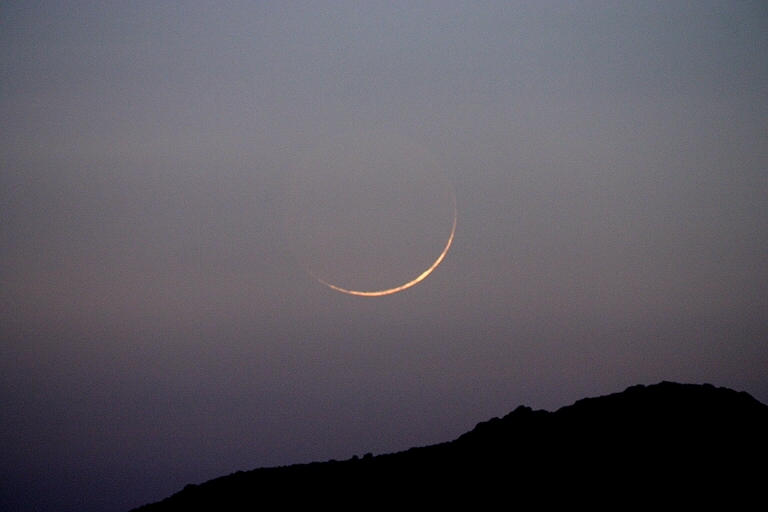
One of the most challenging and demanding observational and photographical projects one may undertake involves the
new moon or, to be more specific, the very thin and young crescent immediately after the new moon. Such a project
also has religious ramifications, for certain religions and cultures place a heavy emphasis on the citing of the new
moon whereby it determines the start of the new (lunar) month which begins the
following day and, in some instances, also establishes
the end of holidays (ex. Ramadan).
The record for sighting the very young crescent moon with the aid of optics such as binoculars or a telescope is under
12 hours (see here)
whereas the record for a sighting without any optical aid(s) is 14.5 to 15.5 hours (see
here and
here). Perhaps the best time to attempt
such an exercise is during spring when both the sun and moon traverse the ecliptic in a nearly perpendicular manner
relative to the horizon, thus allowing for the maximum possible elongation between them near sunset when the sun slowly
begins to dip below the horizon and the young crescent moon is still above it in the western (or northwestern) sky.
This hunt is further aided if the moon is around perigee. For two excellent online articles, the interested reader is
referred to the Sky&Telescope website
here and
here.
Note: The very young lunar crescent illustrated below was captured near the grounds of The
Temple of Poseidon at Sounion, Greece. With a new moon predicted for June 03 at 22:22 UT+3, the image below represents
the moon's phase 23 hours and 17 minutes past new. Its distance of 358,710 km is quite close to the minimum distance
the moon lies from the earth owing to its slightly eccentric orbit, thus making this crescent sliver crescent also a
perigee young moon. The crescent moon was first located using binoculars when approximately ten degrees above the local
horizon. Within minutes, the crescent sliver was placed at the prime focus of a Takahashi FSQ and where a stunning
view of our closest celestial neighbour was observed over the course of 10-15 minutes. Focusing was aided by the presence
of some cellular phone antennae immediately to the east of the setting moon.
|
Body: Moon Mass: 0.0123 x Earth Mean Eq Diameter: 0.2719 x Earth Distance: 358,710 km Sidereal Rev: 27d 07h 43m 11s Age: 00d 23h 17m Phase: 01.6 % Diameter: 33.54' Magnitude: -05.4 Rukl: N/A |
 |
Date: June 04, 2008 21:39:38 UT+3 Location: Sounion, Greece (37.6520° N, 24.0264° E) Equipment: Tak FSQ 106/f5 Canon EOS 300d Exposures: 1 x 0.6 sec ISO 800 RAW Image Format 3072x2048 image size Manual Mode Software: Digital Photo Pro V1.6.1.0 Photoshop CS2 Processing: RAW to 16-bit conv Unsharp Masking Resampling JPG Compression |